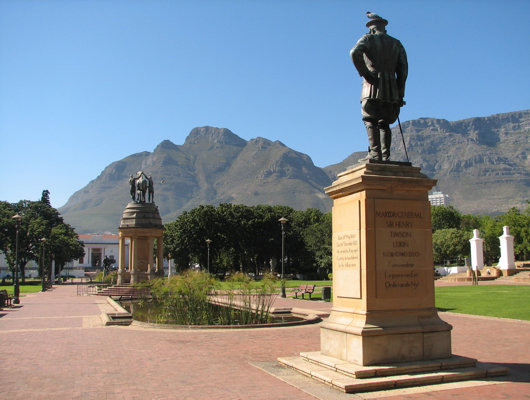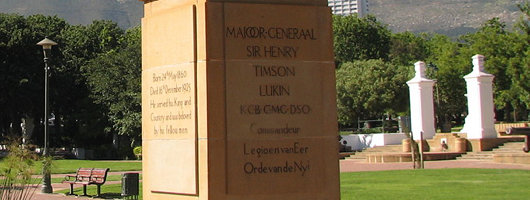
About Andrew Cusack
 Writer, web designer, etc.; born in New York; educated in Argentina, Scotland, and South Africa; now based in London.
Writer, web designer, etc.; born in New York; educated in Argentina, Scotland, and South Africa; now based in London. read more
News
Blogs
Reviews & Periodicals
Arts & Design
World
France
Mitteleuropa
Knickerbockers
Argentina
The Levant
Africa
Cape of Good Hope
Netherlands
Scandinavia
Québec
India
Muscovy
Germany
Academica
The Major-General’s Statue
Die staanbeeld van Maj-Gen Lukin in die Kompanjiestuin

While Afrikaans is a mild obsession of mine, I do like finding those holdouts of what they used to call “High Dutch” — in contrast to the ordinary South African spoken Dutch which, because of its differences in grammar and spelling, was eventually recognised as the language Afrikaans.
One such old Dutch holdout can be found on the statue (Af: staanbeeld; lit.: ‘standing-picture’) of Maj. Gen. Sir Henry Timson Lukin in the Company’s Garden, Cape Town. The pedestal proclaims in a very handsome font the General’s rank, name, and orders. In Dutch: Majoor-Generaal Sir Henry Timson Lukin, KCB CMG DSO, Commandeur Legioen van Eer, Orde van de Nyl.
Most of this works perfectly well as Afrikaans but for two slight differences. First: The lack of ‘i’ in de always indicates Dutch rather than Afrikaans, but because of the relative youth of Afrikaans, de can sometimes be employed as an antiquating device. For example, when translating the name of Captain Haddock’s ship in the Afrikaans translation of the Tintin book, the translators chose De Eenhorn (the Unicorn) rather than Die Eenhorn. Obviously an old-fashioned sailing ship would belong to a Dutch-speaking era rather than an Afrikaans-speaking one.
Second is the military rank. Here translated as majoor-generaal, in both Dutch and Afrikaans this evolved into generaal-majoor. Just one of those things. The South African Defence Forces has a history of experimental military ranks which did not last: Commandant-General (for General), Combat General (for Major General), Colonel-Commandant (for Brigadier), Commandant (for Lieut. Colonel), and Field Cornet (for Lieutenant).
There’s your random bit of Afrikaans arcana for the day.

Search
Instagram: @andcusack
Click here for my Instagram photos.Most Recent Posts
- Sag Harbor Cinema March 26, 2025
- Teutonic Takeover March 10, 2025
- Katalin Bánffy-Jelen, R.I.P. March 3, 2025
- Substack Cusackiensis March 3, 2025
- In the Courts of the Lord February 13, 2025
Most Recent Comments
Book Wishlist
Monthly Archives
Categories



what a beautiful place